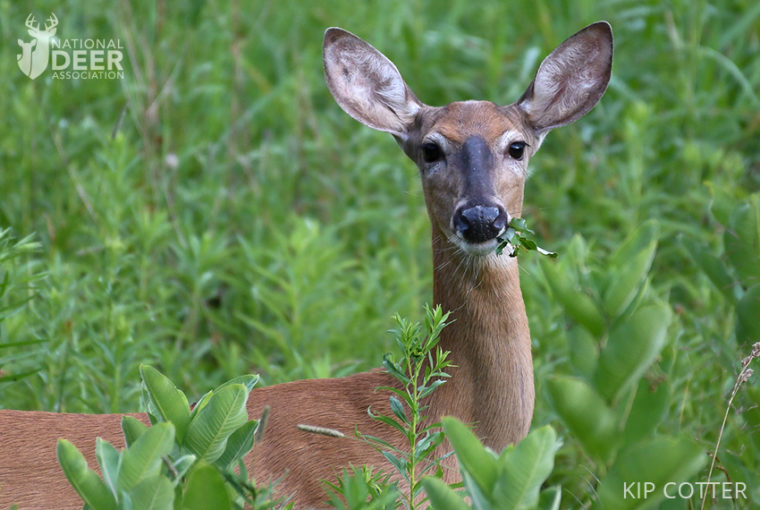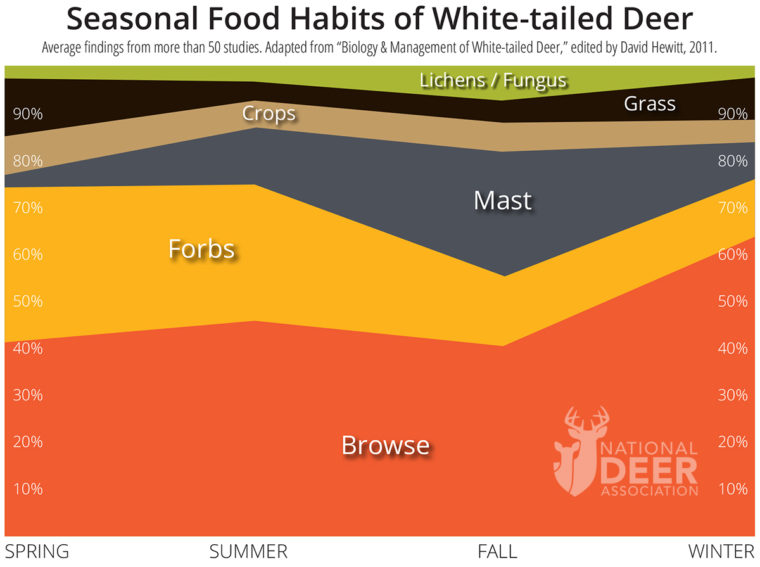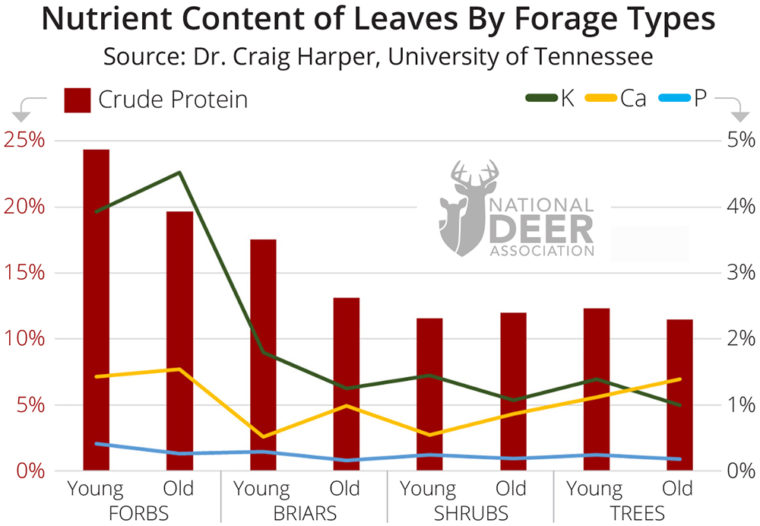
White-tailed deer are absolute plant-eating machines, but understanding what foods they prefer to eat will vastly improve your knowledge and effectiveness in both managing and hunting them.
A deer needs to consume about 6% to 8% of its body weight daily, from spring through fall, in green foliage and browse, to stay healthy. That’s a lot. Like, an insane amount. Because of that requirement, when deer are not bedded down they are continuously on the move searching for something to eat. However, due to their relative size and the need to run away from danger in a moment’s notice, the foods they’re typically on the lookout for are ones that give them the biggest bang for their buck. In other words, they concentrate on the best foods available. In quality deer habitat with diverse forage species, they will choose nutrient-rich plants that taste good and have very high levels of digestibility, thereby maximizing intake of protein, energy and minerals with each bite.
This behavior has earned white-tailed deer the moniker of “concentrate selector” as a means to describe their broad foraging strategy. Physical and behavioral adaptations over time have led to a modern whitetail that’s laser-focused and efficient in food choice, so they come to the table well-equipped to eat!
Fork and Spoon
Deer utensils include:
- Eyes – Whitetail eyes are set back from their mouth so they can see what they’re eating, which assists with selectivity.
- Nose – Their sense of smell is acute enough that deer have the ability to identify foods that are most palatable as well as those that contain toxins before even tasting it.
- Mouth – Whitetails have a narrow snout and long, prehensile tongue which allow them to stick their nose right into vegetation, avoiding what they don’t want to eat – like coarse woody stems, older leaves and thorns – to carefully snap and pull specific plant parts into their chompers.
- Teeth – As high-functioning herbivores, whitetails have teeth that are precisely designed to grab, sheer off and grind/crush plant parts into a consistency that they can swallow quickly.
- Saliva – Deer salivary glands produce enzymes that help deactivate secondary plant compounds that disrupt digestion, such as tannins found in acorns.
- Stomach – White-tailed deer are prey animals that also happen to be ruminants. That combination of physiology and placement on the food chain permits them to consume as much biomass as possible when feeding, followed by further chewing, breaking down and digesting what they’ve eaten once they have retreated into cover.
Today’s Special
As described above white-tailed deer have the ability to consume incredibly high volumes of the most choice parts of preferred plants on the landscape. However, what sort of choices are they making when selecting plants to eat?
According to Dr. Dave Hewitt from the Ceasar Kleberg Wildlife Research Institute at Texas A&M- Kingsville, on an annual basis and averaging across regions and seasons, the white-tailed deer’s diet is dominated by browse (46%), followed by forbs (24%), mast (11%), and crops (4%). The remained includes various other food items such as mushrooms and lichen.

Plants can be classified and grouped in an assortment of ways. Let’s look at each category cited in the graph above to begin breaking down a deer’s diet.
Browse – The leaves, buds and ends of twigs of woody to semi-woody, broad-leaved plants. Examples: trees, shrubs, briars and most vines. Browse is often the result of mid- and late-successional plant growth, which is the predominant cover type found across most hunting lands in the United States, so it’s more common on the landscape where white-tailed deer live and thus a large component of their diet. What’s more, the woody portions are often the only thing on the menu during winter months, north or south. However, woody browse tends to be only moderately preferred because of its higher fiber content and lower digestibility. When deer eat browse they are undoubtedly consuming the youngest shoots and leaves within reach (these parts have the highest digestible energy), so they’re still concentrating on the best food available.
Forbs – Leaves and stems of non-woody (herbaceous), broad-leaved plants. Examples: “weeds”, some commercial crops (i.e., soybeans), and really anything that’s not a browse or grass. Forbs generally appear soon after soil disturbance or after sunlight has been restored to an area, and are a major component of a deer’s diet when available – which is mostly late spring and summer. Many forbs are easily digestible, palatable and contain ample nutrient levels for deer to thrive. In regions and neighborhoods where there is a lot of forb growth on the ground, deer key in on them and are definitely consuming as much, if not more, than browse.
Mast – Hard or soft fruiting bodies. Examples: acorns, nuts, berries, apples, etc. Mast can be a seasonally important energy source for deer that provides pulses of nutrient-rich forage, with soft mast supplementing their diet in summer and hard mast playing a major role from fall well into winter. Soft fruits are typically high in sugars and vitamins, and hard mast is high in fats and carbohydrates. Mast availability is fickle, however, and highly dependent on factors such as vegetation age, sunlight, pollinators, precipitation, other consumers, as well as cyclic production of boom and bust years. When mast is on the scene, deer will find it.
Grass – Leaves and stems of non-woody (herbaceous), narrow-leaved plants that originate from a single stem during development (browse and forbs emerge from seed with two stems). Examples: warm and cool-season grasses, sedges and some crops, such as corn. With the exception of annual cereal grains, deer are not really grass eaters. They almost never consume perennial grasses, which are widespread. Average grass consumption is highest in late winter and early spring because cool-season grasses are often the first green forage available, but their overall importance is relatively low because grasses are less digestible and contain lower nutrient content compared to more desirable forages. If you see deer chomping on tall fescue, that’s a problem.
Lichen/Fungus – Simple, low-growing organisms that form on trees, rocks and in the soil. Examples: old man’s beard, moss, and mushrooms. This category includes a suite of plant and plant-like items ever present within the deer’s diet annually but never at more than a small percentage. These foods vary in availability as well as provide a range of nutritive function, serving as either emergency and/or surplus forages.
Although there’s a clear ranking of the annual consumption of the above food categories within the graph, does that mean these same things are what they’re eating where you hunt? Or, better yet, do the data suggest it’s what deer want to eat?
Dr. Hewitt points out in his book Biology and Management of White-tailed Deer, these broad selection patterns are often masked by “important geographic and seasonal variations.” For example, as higher quality forages flux from abundant to unavailable, low-palatability foods become more important and constitute larger portions of the whitetail diet. A perfect case for this can be made by simply looking at variation between regions at different times of the year. During winter months browse use has a strong latitudinal gradient, with northern herds relying on them significantly more compared to southern populations that can access forbs later in the year. Moreover, fall diets vary the most among regions, and preference is hinged heavily on mast presence. Locations and times that observe mast drop see these shifts in deer activity to focus on such food sources; hence the importance of in-season scouting.
Still, to really digest the facts related to food preference for deer, we need to look at the nutrition inside these plants as well as what categories go on their plate at the buffet line when they’re actually given a choice!
Picky Eater
If you were to type out a collection of known plants eaten by deer in any particular state or province, that list would fill 8-plus pages of a standard single-spaced Microsoft Word document. Point being, whitetails eat a lot of different things. However, although they consume literally hundreds of plant species, only a portion of those species typically account for the majority of their diet. One project in Oklahoma found roughly 1/3 of consumed plants made up on average 93% of the overall diet of deer in that study. Thus, despite the fact that deer have access to and eat a lot of plants, they’re fairly picky eaters in the big scheme of things. Why?
Deer tend to be finicky because they’re constantly trying to balance their overall intake of nutrients with changes in seasons, forage abundance, quality, perceived risk, as well as their own life stage and corresponding protein and/or energetic needs. Of course, with changes in growing seasons comes the predictable, annual ebb and flow of plant growth and drying-out and thus nutrient availability, but recent research has shown that forage nutrients change significantly by plant type, too.

Dr. Craig Harper from the University of Tennessee wanted to learn more about why deer selectively browse certain plants and plants parts and if there was a nutritional explanation to the common observation that deer seem to always bite off the newest growth from preferred forages. So, his team compiled average concentrations of crude protein (CP), phosphorus (P), potassium (K) and calcium (Ca) relative to plant age for four categories of vegetation. As you can see in the above graph, in most categories the younger the plant part the greater the nutrient content. Moreover, non-woody forages with higher digestibility such as forbs and briars maintained higher average nutritional concentrations compared to woody plants like shrubs and trees. Therefore from an energetic perspective whitetails likely get the best nutritional ROI by selecting for non-woody, young forages when they’re up and feeding.
Unless local land management includes frequent disturbance intervals and is constantly working toward increasing the amount and quality of early successional growth, deer likely aren’t consuming what they want to eat regardless of season.
More than Dessert
So, whats the take home message? White-tailed deer desire to eat foods that are palatable, nutritious and easily digestible, and forbs are one of the most preferred food categories that provide those attributes. Also besides forage preference, availability drives food selection and changes in availability can result in dramatically different food habits within small areas and/or over time. Thus, providing a diversity of forage types is critical. For hunters, success will be strongly tied to knowing what deer want to eat and locating it on your hunting area at any given time. From a land management perspective, do your best to maximize the amount of preferred deer foods that grow in every season through various habitat techniques.
When you’ve achieved both, you absolutely get your cake and eat it, too.









